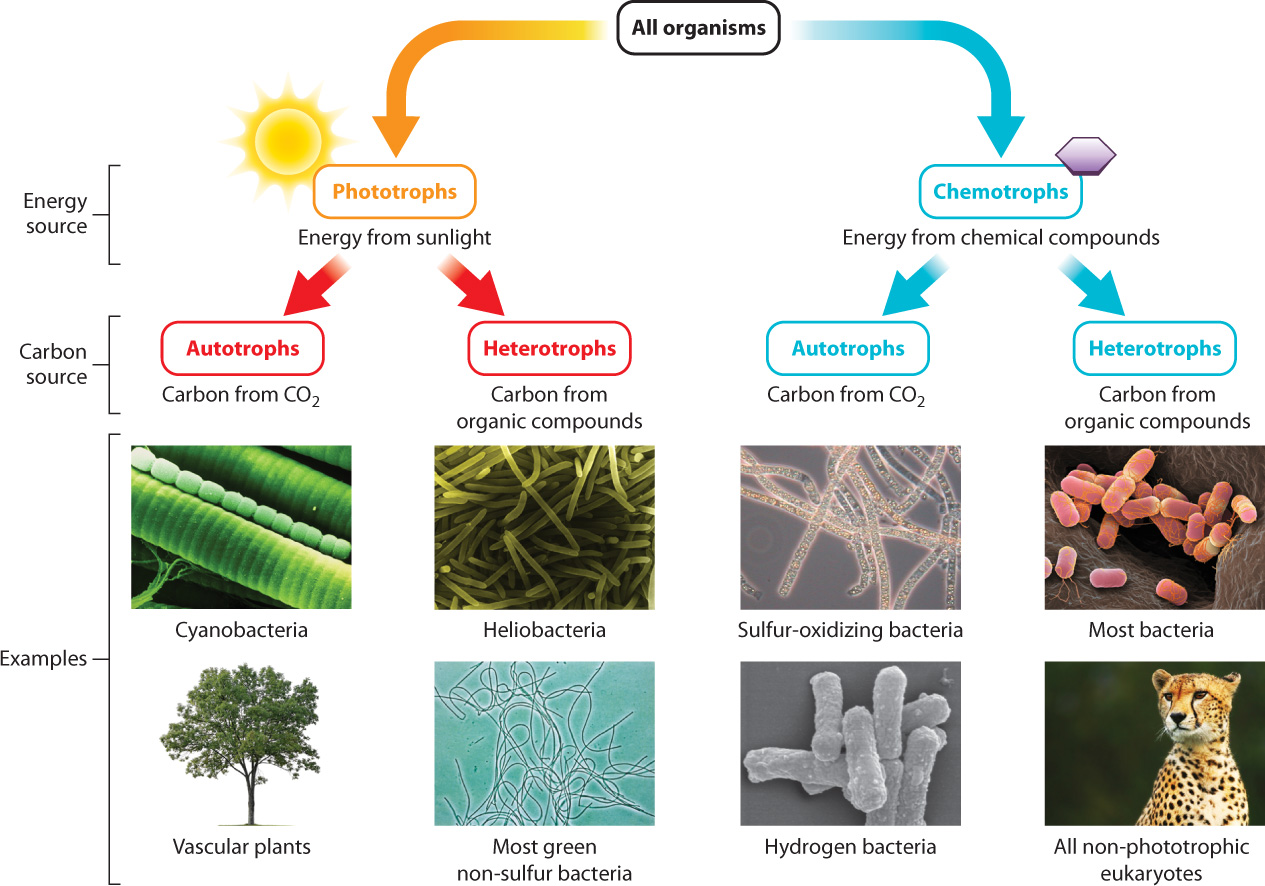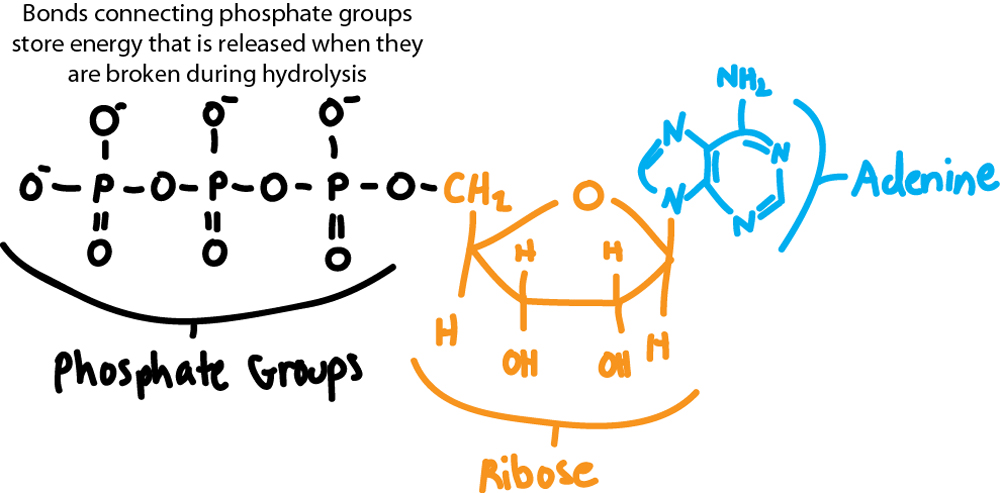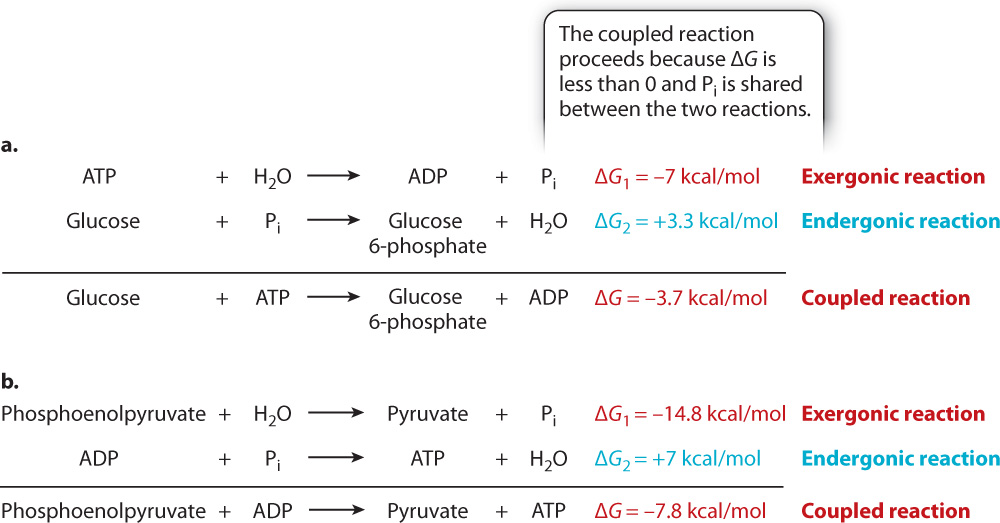CHAPTER SUMMARY
6.1 METABOLISM IS THE SET OF BIOCHEMICAL REACTIONS THAT TRANSFORMS BIOMOLECULES AND TRANSFERS ENERGY
- Organisms can be grouped according to their source of energy: Phototrophs acquire energy from sunlight and chemotrophs obtain energy from chemical compounds.
- Organisms can also be grouped according to the source of carbon they use to build organic molecules: Heterotrophs obtain carbon from organic molecules, and autotrophs obtain carbon from inorganic carbon, such as carbon dioxide.
- Catabolism is the set of reactions that break down molecules and release energy, and anabolism is the set of reactions that build molecules and require energy.
6.2 THE ENERGY OF A SYSTEM IS ITS CAPACITY TO DO WORK.
- Kinetic energy is the energy of motion.
- Potential energy is stored energy and depends on the structure of an object or its position relative to its surroundings.
- Chemical energy is a form of potential energy held in the bonds of molecules.
6.3 THE LAWS OF THERMODYNAMICS GOVERN ENERGY FLOW IN BIOLOGICAL SYSTEMS.
- The first law of thermodynamics states that energy cannot be created or destroyed.
- The second law of thermodynamics states that there is an increase in disorder or entropy in the universe over time.
6.4 CHEMICAL REACTIONS ARE SUBJECT TO THE LAWS OF THERMODYNAMICS.
- In a chemical reaction, atoms themselves do not change, but the bonds linking the atoms change to form new molecules.
- Many chemical reactions are reversible.
- The direction of reversible reactions is influenced by the concentration of reactants and products.
- Gibbs free energy (G) is the amount of energy available to do work.
- Three thermodynamic parameters define a chemical reaction: Gibbs free energy (G), enthalpy (H), and entropy (S), and the change of free energy in a chemical reaction is described by ΔG = ΔH − T Δ S.
- Exergonic reactions are spontaneous (ΔG < 0) and release energy.
- Endergonic reactions are non-spontaneous (ΔG > 0) and require energy.
- The hydrolysis of ATP is an exergonic reaction that is used to drive many endergonic reactions in a cell.
- In living systems, non-spontaneous reactions are often coupled to spontaneous ones.
6.5 THE RATE OF BIOCHEMICAL REACTIONS IS CONTROLLED BY PROTEIN CATALYSTS CALLED ENZYMES.
- Enzymes reduce the free energy level of the transition state between reactants and products, thereby reducing the energy input, or activation energy, required for a chemical reaction to proceed.
- During catalysis, the substrate and product form a complex with the enzyme. Transient covalent bonds and/or weak noncovalent interactions stabilize the complex.
- The size of the active site of an enzyme is small compared to the size of the enzyme as a whole and the active site amino acids occupy a very specific spatial arrangement.
- An enzyme is very specific toward its substrate and the types of reactions it catalyzes.
- Inhibitors reduce the activity of enzymes. They can act irreversibly or reversibly.
- Activators increase the activity of enzymes.
- Allosteric enzymes bind activators and inhibitors at sites other than the active site, resulting in a change in their shape and activity.
- Allosteric enzymes are often found at or near the start of a metabolic pathway or at the crossroads of multiple pathways.
Self-Assessment Question 1
Describe four ways in which organisms obtain energy and carbon from the environment.
Show Model Answer
Model Answer:
Organisms can obtain energy from the environment in two ways: (1) energy harvested from sunlight (phototrophs), and (2) energy harvested from chemical compounds (chemotrophs). These groups are further distinguished by how they obtain the carbon that their cells need. Autotrophs obtain carbon directly from inorganic sources—such as carbon dioxide—and convert it into an organic source of carbon, like glucose. Heterotrophs obtain carbon from organic compounds made by other organisms. (See Figure 6.1 for examples.)

Self-Assessment Question 2
Distinguish between catabolism and anabolism.
Show Model Answer
Model Answer:
Catabolism is the set of chemical reactions that break down macromolecules into smaller units, producing energy (ATP). Anabolism is the set of chemical reactions that build macromolecules from smaller units and require the input of energy (usually in the form of ATP).
Self-Assessment Question 3
Define energy; describe the two forms that it takes and provide an example of each.
Show Model Answer
Model Answer:
Energy is a system’s capacity to do work. The first form of energy is kinetic energy (the energy of motion). Moving objects perform work that results in the movement of themselves and the surrounding matter. Examples of kinetic energy are flexing a muscle, throwing a ball, basically any kind of movement. The second form of energy is potential energy (stored energy).
Potential energy depends on the structure of the object or its position relative to its surroundings, and it is released by a change in the object’s structure or position. A ball sitting on the top of the stairs has a great deal of potential energy, which is released when the ball starts to roll down the stairs (at which point the energy is converted into kinetic energy).
Self-Assessment Question 4
Explain how molecules contain chemical energy in their bonds.
Show Model Answer
Model Answer:
Chemical energy in molecules is stored as potential energy of the electrons in atoms, occupying orbitals at various distances from the nucleus. The farther away an electron is from the nucleus, the more potential energy it has. When an electron moves closer to the nucleus, some of its potential energy is converted to other types of energy (like heat or light). In a covalent bond, atoms share electrons. When the shared electrons are far away from both nuclei, they have a great deal of potential energy. Carbohydrates, lipids, and proteins are a rich source of this chemical energy.
Self-Assessment Question 5
Draw the structure of ATP, indicating the bonds that are broken during hydrolysis.
Show Model Answer
Model Answer:

Self-Assessment Question 6
Name and describe the first and second laws of thermodynamics.
Show Model Answer
Model Answer:
See Figures 6.6 and 6.7. The first law of thermodynamics is the law of conservation of energy. It states that energy can neither be created nor destroyed; it can only be transformed from one form into another. For example, when an electron moves from a higher energy level to a lower one, it emits light or heat. The energy it takes to move the electron down a level is equal to the amount of energy released as heat or light. The second law of thermodynamics states that the transformation of energy is associated with an increase in the disorder of the universe. The degree of disorder is called entropy. In the example of the electron moving down energy levels, the heat emitted from the movement will increase the amount of disorder in the universe (or an increase in entropy).
Self-Assessment Question 7
Given a set of thermodynamic parameters, indicate whether a chemical reaction is spontaneous or not.
Show Model Answer
Model Answer:
The amount of energy available to do work is called Gibbs free energy (G). In a chemical reaction, you compare the free energy of the reactants and products to determine whether there is energy available to do work. This difference is called ΔG. If the products of a reaction have less free energy than the reactants, ΔG is negative and energy is released. This kind of reaction occurs spontaneously (also called exergonic). If the ΔG is positive, meaning that the products of the reaction have more free energy than the reactants so that an input of energy is required to drive the reaction forward, this reaction is not spontaneous (also called endergonic).
Self-Assessment Question 8
Describe how the hydrolysis of ATP can drive non-spontaneous reactions in a cell.
Show Model Answer
Model Answer:
The hydrolysis of the high energy phosphate bonds in ATP releases energy. This energy can be used to drive non- spontaneous reactions in a cell if the total ΔG for the entire pathway is negative. See Figure 6.12.

Self-Assessment Question 9
Give three characteristics of enzymes.
Show Model Answer
Model Answer:
Enzymes reduce the activation energy of a chemical reaction (or the energy input necessary to reach the transition state) by stabilizing the transition state and decreasing its free energy. See Figure 6.14. Enzymes are catalysts that participate in a chemical reaction, forming complexes with products and reactants, but are not themselves consumed in the process. See Figure 6.15. Enzymes are also highly specific. They typically catalyze only one reaction, recognizing a specific substrate. Finally, inhibitors and activators can influence enzyme activity. Inhibitors decrease the activity of enzymes, whereas activators increase this activity. See Figure 6.19 for an example of two different types of inhibitors.
Self-Assessment Question 10
Explain how protein folding allows for enzyme specificity.
Show Model Answer
Model Answer:
The three-dimensional shapes of proteins are very important in allowing for enzyme specificity. The enzyme has to fold into its correct shape in order for the active site (the portion of the enzyme that binds substrate and converts it to product) to be in the right area and shape. An enzyme will only recognize its substrate if its active site is in the right conformation due to the correct three-dimensional folding.